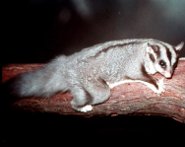 The squirrel glider (Petaurus norfolcensis) is a gliding mammal, somewhat similar to a possum, with a skin membrane covered with fur stretching between its front and hind legs. It’s of the marsupial family Petauridae, and is one of the wrist-winged gliders of the genus Petaurus. The squirrel glider is very similar in appearance to the sugar glider, a smaller relative. Its upper side is a pearl-grey hue and its underside is white. This glider also has a black line from between its eyes down to its lower back. The tail is very long and bushy, with a grey color shading to black at the tip.
The squirrel glider (Petaurus norfolcensis) is a gliding mammal, somewhat similar to a possum, with a skin membrane covered with fur stretching between its front and hind legs. It’s of the marsupial family Petauridae, and is one of the wrist-winged gliders of the genus Petaurus. The squirrel glider is very similar in appearance to the sugar glider, a smaller relative. Its upper side is a pearl-grey hue and its underside is white. This glider also has a black line from between its eyes down to its lower back. The tail is very long and bushy, with a grey color shading to black at the tip.The squirrel glider is not a large animal, measuring in at 48 cm (18.9 inches). Of that length, 28 cm (11 inches) belongs to the tail, thus making the tail longer than the body. The weight of an adult averages about 230 grams, or approximately 8 oz (0.5 lbs).
The squirrel glider is able to glide from tree to tree, sometimes even at distances up to 50 meters, or about 164 feet. Generally, they glide shorter distances, though. This enables the glider to avoid predators they would otherwise meet on the ground. Not only can this animal glide using its skin membrane, it can also use its long tail to hold on to branches. However, the tail usually acts as a rudder when the animal is gliding.
The squirrel glider nests in tree hollows padded with leaves. It tends to live in family groups comprised of about 9 members, usually one mature male with 2 females and offspring. The gliders breed between June and January, producing one or two offspring each year, which are weaned after 4 months and are independent by 10 months. Gliders live from 4-6 years in the wild.
The squirrel glider is endemic, or unique, to Australia, and is found particularly in eastern Australia. Though sparsely distributed, the squirrel glider is found from western Victoria to northern Queensland. It prefers habitats such as mature River Red gum forest and Box or Box-Ironbark woodlands which lie west of the Great Dividing Range, as well as Bloodwood forests in the coastal areas. It also favors mixed eucalypt forests with an acacia understory. The glider needs well-connected, lush tree canopies for gliding amongst.
The squirrel glider isn't an endangered species, but is threatened by various human activities such as clearing or breaking up of habitats, such as areas where roads cut through forest canopies and gliding distances are too great. Losing old-growth, mature, hollow-bearing trees also imperils the glider. The squirrel glider has predators such as owls, foxes, cats and dogs.
Keywords: nocturnal
The Squirrel glider is listed as Near Threatened (LR/nt), is close to qualifying for or is likely to qualify for a threatened category in the near future, on the IUCN Red List of Threatened Species
Countries
AustraliaSome facts about the
Squirrel glider
Adult weight : 0.405 kg (0.891 lbs)
Maximum longevity : 15 years
Gestation : 20 days
Weaning : 122 days
Litter size : 2
Interval between litters : 183 days

Custom Search